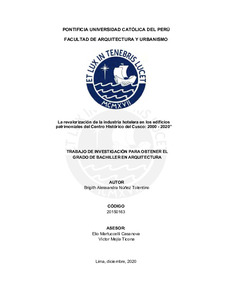| dc.contributor.advisor | Martuccelli Casanova, Elio Miguel | |
| dc.contributor.advisor | Mejía Ticona, Víctor Ramiro | |
| dc.contributor.author | Núñez Tolentino, Brigith Alessandra | |
| dc.date.accessioned | 2024-01-19T14:42:03Z | |
| dc.date.available | 2024-01-19T14:42:03Z | |
| dc.date.created | 2020 | |
| dc.date.issued | 2024-01-19 | |
| dc.identifier.uri | http://hdl.handle.net/20.500.12404/26828 | |
| dc.description.abstract | La arquitectura patrimonial y el turismo tienen una estrecha relación, debido al interés por su
atractivo. Desde el 2000, el incremento del flujo turístico, produjo una demanda de servicios
(hospedaje, agencias de viaje, restaurantes, etc). Generando un incremento de intervenciones
patrimoniales en el Centro Histórico del Cusco, transformándolo en una zona turística de
museos, restaurantes, tiendas, recreación y hospedaje. Estas intervenciones son un reto, para
la adaptación de nuevos usos en los edificios antiguos, así como la construcción de nuevos
edificios contemporáneos. Los cuales, se basan mediante estrategias de conservación, para
no alterar la imagen del Centro Histórico y generar la sostenibilidad de las tipologías
existentes, por ello es importante comprender cómo actúan las intervenciones en edificios
patrimoniales.
Se estudia tres hoteles de cinco estrellas ubicados en el Centro Histórico del Cusco, los
hoteles Belmond, Marriot y Sheraton, cuya finalidad es definer los procesos que afronta el
patrimonio en el siglo XXI. Se observa que la privatización de los edificios patrimoniales
genera una fragmentación y exclusión social, pues las intervenciones y apropiaciones del
patrimonio se expanden hasta el espacio público para satisfacer a los visitantes. Así como,
implementan procesos de restauración, para conservar elementos existentes en el edificio y
establecer una relación de los nuevos sistemas constructivos frente al edificio actual y generar
una armonía entre estos, donde el actual caso del Hotel Sheraton, sigue siendo tan
controversial, por el hecho de destruir el patrimonio que se encontraba en el lugar y contruir
un nuevo edificio que no se relaciona con el entorno. Se concluye que la intervención en el
Centro Histórico es buscar una armonía entre los edificios pre-exitentes y las nuevas
construcciones, sin dejar de lado la escencia del lugar. Donde el nuevo edificio, genere una
nueva relación con el ciudadano y el visitante. | es_ES |
| dc.description.abstract | Heritage architecture and tourism have a close relationship, due to the interest in its
attractiveness. Since 2000, the increase in the tourist flow produced a demand for services
(lodging, travel agencies, restaurants, etc.). Generating an increase in heritage interventions
in the Historic Center of Cusco, transforming it into a tourist area of museums, restaurants,
shops, recreation and lodging. These interventions are a challenge, for the adaptation of new
uses in old buildings, as well as the construction of new contemporary buildings. Which are
based on conservation strategies, so as not to alter the image of the Historic Center and
generate the sustainability of existing typologies, therefore it is important to understand how
interventions in heritage buildings act.
Three five-star hotels located in the Historic Center of Cusco, the Belmond, Marriot and
Sheraton hotels, are taken as a study, whose purpose is to define the processes that
heritage faces in the 21st century. It is observed that the privatization of heritage buildings
generates fragmentation and social exclusion, since interventions and appropriations of
heritage expand to the public space to satisfy visitors. As well as, they implement restoration
processes, to conserve existing elements in the building and establish a relationship of the
new construction systems in front of the current building and generate a harmony between
them, where the current case of the Sheraton Hotel continues to be so controversial, due to
the fact of destroying the heritage that was in the place and building a new building that is
not related to the environment. It is concluded that the intervention in the Historic Center is to
seek a harmony between the pre-existing buildings and the new constructions, without
neglecting the essence of the place. Where the new building generates a new relationship
with the citizen and the visitor. | es_ES |
| dc.language.iso | spa | es_ES |
| dc.publisher | Pontificia Universidad Católica del Perú | es_ES |
| dc.rights | info:eu-repo/semantics/openAccess | es_ES |
| dc.rights.uri | http://creativecommons.org/licenses/by-sa/2.5/pe/ | * |
| dc.subject | Arquitectura--Aspectos culturales--Perú--Cuzco | es_ES |
| dc.subject | Patrimonio cultural--Perú--Cuzco--Centro histórico | es_ES |
| dc.subject | Espacio en arquitectura--Perú--Cuzco | es_ES |
| dc.title | La revalorización de la industria hotelera en los edificios patrimoniales del Centro Histórico del Cusco: 2000 - 2020 | es_ES |
| dc.type | info:eu-repo/semantics/bachelorThesis | es_ES |
| thesis.degree.name | Bachiller en Arquitectura | es_ES |
| thesis.degree.level | Bachillerato | es_ES |
| thesis.degree.grantor | Pontificia Universidad Católica del Perú. Facultad de Arquitectura | es_ES |
| thesis.degree.discipline | Arquitectura | es_ES |
| renati.advisor.dni | 08274225 | |
| renati.advisor.dni | 10556604 | |
| renati.advisor.orcid | https://orcid.org/0000-0003-3823-0664 | es_ES |
| renati.advisor.orcid | https://orcid.org/0000-0003-0140-2274 | es_ES |
| renati.author.dni | 72539523 | |
| renati.discipline | 731026 | es_ES |
| renati.level | https://purl.org/pe-repo/renati/level#bachiller | es_ES |
| renati.type | https://purl.org/pe-repo/renati/type#trabajoDeInvestigacion | es_ES |
| dc.publisher.country | PE | es_ES |
| dc.subject.ocde | https://purl.org/pe-repo/ocde/ford#6.04.08 | es_ES |






